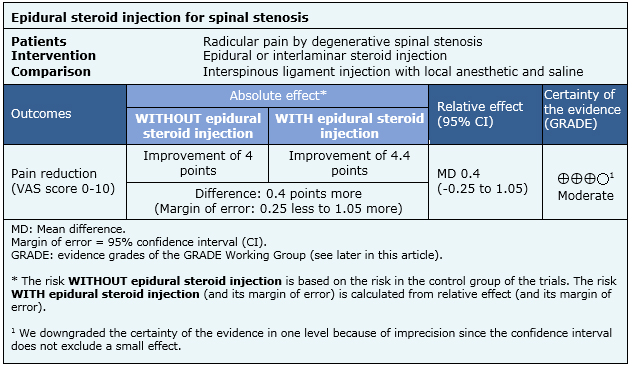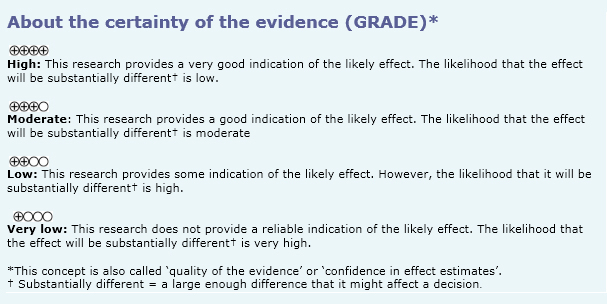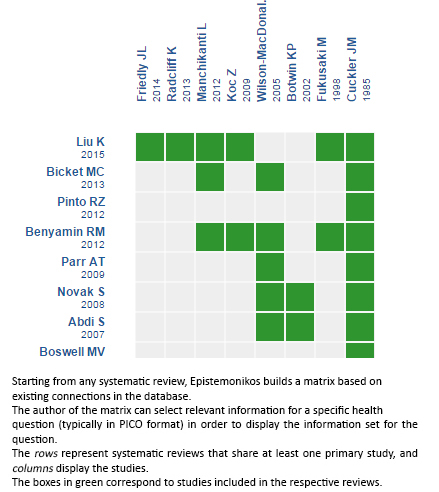 Para Descargar PDF debe Abrir sesión.
Para Descargar PDF debe Abrir sesión.
There are several nonsurgical alternatives to treat radicular pain in degenerative lumbar spinal stenosis. Epidural steroid injections have been used for several decades, but the different studies have shown variable effects. Searching in Epistemonikos database, which is maintained by screening 30 databases, we identified nine systematic reviews including seven pertinent randomized controlled trials. We concluded epidural steroid injection probably leads to little or no effect on reducing radicular pain of spinal stenosis.
Degenerative lumbar spinal stenosis is a condition in which the area of the spinal canal decreases because of disc degeneration and facet joint osteoarthritis, predominantly in people over 65 years old. Its main symptom is intermittent neurogenic claudication, which restricts the possibility of walking due to pain in the extremities, causing a significant deterioration in the quality of life.
Among the nonsurgical alternatives epidural steroid injection is often used in order to achieve symptomatic relief, improve functionality and possibly avoid surgery. Among its risks are radicular injury, post puncture headache, metabolic disorders, rash, insomnia, among others [1].
We used Epistemonikos database, which is maintained by screening more than 30 databases, to identify systematic reviews and their included primary studies. With this information, we generated a structured summary using a pre-established format, which includes key messages, a summary of the body of evidence (presented as an evidence matrix in Epistemonikos), meta-analysis of the total of studies, a summary of findings table following the GRADE approach and a table of other considerations for decision-making.
|
Key messages
|
About the body of evidence for this question
|
What is the evidence. |
We found nine systematic reviews [2],[3],[4],[5],[6],[7],[8],[9],[10] considering eight primary studies [11],[12],[13],[14],[15],[16],[17],[18], including seven randomized controlled trials [11],[12],[13],[15],[16],[17],[18]. This table and the summary in general are based on the latter. Only one of seven randomized trials presented data that could be included in the summary of findings [13]. The remaining studies were only used for the considerations for decision-making. |
|
What types of patients were included |
Five studies included patients with radicular pain caused exclusively by lumbar spinal stenosis [12],[13],[15],[17],[18], while two studies included patients with radicular pain due to spinal stenosis or lumbar herniated nucleus pulposus [11],[16]. |
|
What types of interventions were included |
The seven studies included in this summary used as intervention interlaminar epidural injection of steroids [11],[12],[13],[15],[16],[17],[18]. Two studies did not mention which corticosteroid was used [12],[17], three studies used methylprednisolone [11],[16],[18], one betamethasone [13] and one triamcinolone [15]. Of the three studies using methylprednisolone one administered 40 mg [18], while the other two used 80 mg [11],[16]. The study using betamethasone administered 6 mg [13], while the study with triamcinolone used 60 mg [15]. Four studies did not mention how many injections they used [12],[13],[15],[16], and the other three used two or more injections [11],[17],[18]. Five studies compared against placebo using a single injection in the same place with local anesthetics [11],[13],[16],[17],[18]. One study compared against a group without intervention [15] and one study did not make clear which intervention was used [12]. |
|
What types of outcomes |
The outcomes measured were reduction of lower extremity pain in a visual analogue scale (VAS) score, and change in disability with the Roland Morris Disability Questionnaire (RMDQ) and the Oswestry Disability Index (ODI). The time in which the effect was measured varied in different studies, ranging from one week to 4 years after the first intervention. However, meta-analysis considered endpoints at 12-weeks. |
The information on the effects of epidural steroid injections is based on only one study that adequately reported the outcome reduction of pain, which includes 60 patients [20].


|
To whom this evidence does and does not apply |
|
| About the outcomes included in this summary |
|
| Balance between benefits and risks, and certainty of the evidence |
|
| Resource considerations |
|
|
Differences between this summary and other sources |
|
| Could this evidence change in the future? |
|
Using automated and collaborative means, we compiled all the relevant evidence for the question of interest and we present it as a matrix of evidence.

Follow the link to access the interactive version: Epidural steroid injection for degenerative lumbar spinal stenosis
The upper portion of the matrix of evidence will display a warning of “new evidence” if new systematic reviews are published after the publication of this summary. Even though the project considers the periodical update of these summaries, users are invited to comment in Medwave or to contact the authors through email if they find new evidence and the summary should be updated earlier. After creating an account in Epistemonikos, users will be able to save the matrixes and to receive automated notifications any time new evidence potentially relevant for the question appears.
The details about the methods used to produce these summaries are described here http://dx.doi.org/10.5867/medwave.2014.06.5997.
Epistemonikos foundation is a non-for-profit organization aiming to bring information closer to health decision-makers with technology. Its main development is Epistemonikos database (www.epistemonikos.org).
These summaries follow a rigorous process of internal peer review.
Conflicts of interest
The authors do not have relevant interests to declare.
 Esta obra de Medwave está bajo una licencia Creative Commons Atribución-NoComercial 3.0 Unported. Esta licencia permite el uso, distribución y reproducción del artículo en cualquier medio, siempre y cuando se otorgue el crédito correspondiente al autor del artículo y al medio en que se publica, en este caso, Medwave.
Esta obra de Medwave está bajo una licencia Creative Commons Atribución-NoComercial 3.0 Unported. Esta licencia permite el uso, distribución y reproducción del artículo en cualquier medio, siempre y cuando se otorgue el crédito correspondiente al autor del artículo y al medio en que se publica, en este caso, Medwave.

There are several nonsurgical alternatives to treat radicular pain in degenerative lumbar spinal stenosis. Epidural steroid injections have been used for several decades, but the different studies have shown variable effects. Searching in Epistemonikos database, which is maintained by screening 30 databases, we identified nine systematic reviews including seven pertinent randomized controlled trials. We concluded epidural steroid injection probably leads to little or no effect on reducing radicular pain of spinal stenosis.
 Autores:
Sebastián Flores[1,3], Marcelo Molina[2,3]
Autores:
Sebastián Flores[1,3], Marcelo Molina[2,3]

Citación: Flores S, Molina M. Is epidural steroid injection effective for degenerative lumbar spinal stenosis?. Medwave 2015;15(Suppl3):e6315 doi: 10.5867/medwave.2015.6315
Fecha de publicación: 16/11/2015

Nos complace que usted tenga interés en comentar uno de nuestros artículos. Su comentario será publicado inmediatamente. No obstante, Medwave se reserva el derecho a eliminarlo posteriormente si la dirección editorial considera que su comentario es: ofensivo en algún sentido, irrelevante, trivial, contiene errores de lenguaje, contiene arengas políticas, obedece a fines comerciales, contiene datos de alguna persona en particular, o sugiere cambios en el manejo de pacientes que no hayan sido publicados previamente en alguna revista con revisión por pares.
Aún no hay comentarios en este artículo.
Para comentar debe iniciar sesión
 Medwave publica las vistas HTML y descargas PDF por artículo, junto con otras métricas de redes sociales.
Medwave publica las vistas HTML y descargas PDF por artículo, junto con otras métricas de redes sociales.
 Bicket MC, Chakravarthy K, Chang D, Cohen SP. Epidural steroid injections: an updated review on recent trends in safety and complications. Pain Manag. 2015;5(2):129-46. | CrossRef | PubMed |
Bicket MC, Chakravarthy K, Chang D, Cohen SP. Epidural steroid injections: an updated review on recent trends in safety and complications. Pain Manag. 2015;5(2):129-46. | CrossRef | PubMed | Abdi S, Datta S, Trescot AM, Schultz DM, Adlaka R, Atluri SL, et al. Epidural steroids in the management of chronic spinal pain: a systematic review. Pain Physician. 2007 Jan;10(1):185-212. | PubMed |
Abdi S, Datta S, Trescot AM, Schultz DM, Adlaka R, Atluri SL, et al. Epidural steroids in the management of chronic spinal pain: a systematic review. Pain Physician. 2007 Jan;10(1):185-212. | PubMed | Parr AT, Diwan S, Abdi S. Lumbar interlaminar epidural injections in managing chronic low back and lower extremity pain: a systematic review. Pain Physician. 2009 Jan-Feb;12(1):163-88. | PubMed |
Parr AT, Diwan S, Abdi S. Lumbar interlaminar epidural injections in managing chronic low back and lower extremity pain: a systematic review. Pain Physician. 2009 Jan-Feb;12(1):163-88. | PubMed | Koes BW, Scholten RJ, Mens JM, Bouter LM. Efficacy of epidural steroid injections for low-back pain and sciatica: a systematic review of randomized clinical trials. Pain. 1995 Dec;63(3):279-88. | PubMed |
Koes BW, Scholten RJ, Mens JM, Bouter LM. Efficacy of epidural steroid injections for low-back pain and sciatica: a systematic review of randomized clinical trials. Pain. 1995 Dec;63(3):279-88. | PubMed | Liu K, Liu P, Liu R, Wu X, Cai M. Steroid for epidural injection in spinal stenosis: a systematic review and meta-analysis. Drug Des Devel Ther. 2015 Jan 30;9:707-16. | CrossRef | PubMed |
Liu K, Liu P, Liu R, Wu X, Cai M. Steroid for epidural injection in spinal stenosis: a systematic review and meta-analysis. Drug Des Devel Ther. 2015 Jan 30;9:707-16. | CrossRef | PubMed | Bicket MC, Gupta A, Brown CH 4th, Cohen SP. Epidural injections for spinal pain: a systematic review and meta-analysis evaluating the "control" injections in randomized controlled trials. Anesthesiology. 2013 Oct;119(4):907-31 | CrossRef | PubMed |
Bicket MC, Gupta A, Brown CH 4th, Cohen SP. Epidural injections for spinal pain: a systematic review and meta-analysis evaluating the "control" injections in randomized controlled trials. Anesthesiology. 2013 Oct;119(4):907-31 | CrossRef | PubMed | Boswell MV, Hansen HC, Trescot AM, Hirsch JA. Epidural steroids in the management of chronic spinal pain and radiculopathy. Pain Physician. 2003 Jul;6(3):319-34. | PubMed |
Boswell MV, Hansen HC, Trescot AM, Hirsch JA. Epidural steroids in the management of chronic spinal pain and radiculopathy. Pain Physician. 2003 Jul;6(3):319-34. | PubMed | Novak S, Nemeth WC. The basis for recommending repeating epidural steroid injections for radicular low back pain: a literature review. Arch Phys Med Rehabil. 2008 Mar;89(3):543-52. | CrossRef | PubMed |
Novak S, Nemeth WC. The basis for recommending repeating epidural steroid injections for radicular low back pain: a literature review. Arch Phys Med Rehabil. 2008 Mar;89(3):543-52. | CrossRef | PubMed | Benyamin RM, Manchikanti L, Parr AT, Diwan S, Singh V, Falco FJ, et al. The effectiveness of lumbar interlaminar epidural injections in managing chronic low back and lower extremity pain. Pain Physician. 2012 Jul-Aug;15(4):E363-404.
| PubMed |
Benyamin RM, Manchikanti L, Parr AT, Diwan S, Singh V, Falco FJ, et al. The effectiveness of lumbar interlaminar epidural injections in managing chronic low back and lower extremity pain. Pain Physician. 2012 Jul-Aug;15(4):E363-404.
| PubMed | Pinto RZ, Maher CG, Ferreira ML, Hancock M, Oliveira VC, McLachlan AJ, et al. Epidural corticosteroid injections in the management of sciatica: a systematic review and meta-analysis. Ann Intern Med. 2012 Dec 18;157(12):865-77. | PubMed |
Pinto RZ, Maher CG, Ferreira ML, Hancock M, Oliveira VC, McLachlan AJ, et al. Epidural corticosteroid injections in the management of sciatica: a systematic review and meta-analysis. Ann Intern Med. 2012 Dec 18;157(12):865-77. | PubMed | Wilson-MacDonald J, Burt G, Griffin D, Glynn C. Epidural steroid injection for nerve root compression. A randomised, controlled trial. J Bone Joint Surg Br. 2005 Mar;87(3):352-5. | PubMed |
Wilson-MacDonald J, Burt G, Griffin D, Glynn C. Epidural steroid injection for nerve root compression. A randomised, controlled trial. J Bone Joint Surg Br. 2005 Mar;87(3):352-5. | PubMed | Radcliff K, Kepler C, Hilibrand A, Rihn J, Zhao W, Lurie J, et al. Epidural steroid injections are associated with less improvement in patients with lumbar spinal stenosis: a subgroup analysis of the Spine Patient Outcomes Research Trial. Spine (Phila Pa 1976). 2013 Feb 15;38(4):279-91.
| CrossRef | PubMed |
Radcliff K, Kepler C, Hilibrand A, Rihn J, Zhao W, Lurie J, et al. Epidural steroid injections are associated with less improvement in patients with lumbar spinal stenosis: a subgroup analysis of the Spine Patient Outcomes Research Trial. Spine (Phila Pa 1976). 2013 Feb 15;38(4):279-91.
| CrossRef | PubMed | Manchikanti L, Cash KA, McManus CD, Damron KS, Pampati V, Falco FJ. Lumbar interlaminar epidural injections in central spinal stenosis: preliminary results of a randomized, double-blind, active control trial. Pain Physician. 2012 Jan-Feb;15(1):51-63.
| PubMed |
Manchikanti L, Cash KA, McManus CD, Damron KS, Pampati V, Falco FJ. Lumbar interlaminar epidural injections in central spinal stenosis: preliminary results of a randomized, double-blind, active control trial. Pain Physician. 2012 Jan-Feb;15(1):51-63.
| PubMed | Botwin KP, Gruber RD, Bouchlas CG, Torres-Ramos FM, Sanelli JT, Freeman ED, et al. Fluoroscopically guided lumbar transformational epidural steroid injections in degenerative lumbar stenosis: an outcome study. Am J Phys Med Rehabil. 2002 Dec;81(12):898-905. | PubMed |
Botwin KP, Gruber RD, Bouchlas CG, Torres-Ramos FM, Sanelli JT, Freeman ED, et al. Fluoroscopically guided lumbar transformational epidural steroid injections in degenerative lumbar stenosis: an outcome study. Am J Phys Med Rehabil. 2002 Dec;81(12):898-905. | PubMed | Koc Z, Ozcakir S, Sivrioglu K, Gurbet A, Kucukoglu S. Effectiveness of physical therapy and epidural steroid injections in lumbar spinal stenosis. Spine (Phila Pa 1976). 2009 May 1;34(10):985-9. | CrossRef | PubMed |
Koc Z, Ozcakir S, Sivrioglu K, Gurbet A, Kucukoglu S. Effectiveness of physical therapy and epidural steroid injections in lumbar spinal stenosis. Spine (Phila Pa 1976). 2009 May 1;34(10):985-9. | CrossRef | PubMed | Cuckler JM, Bernini PA, Wiesel SW, Booth RE Jr, Rothman RH, Pickens GT. The use of epidural steroids in the treatment of lumbar radicular pain. A prospective, randomized, double-blind study. J Bone Joint Surg Am. 1985 Jan;67(1):63-6. | PubMed |
Cuckler JM, Bernini PA, Wiesel SW, Booth RE Jr, Rothman RH, Pickens GT. The use of epidural steroids in the treatment of lumbar radicular pain. A prospective, randomized, double-blind study. J Bone Joint Surg Am. 1985 Jan;67(1):63-6. | PubMed | Friedly JL, Comstock BA, Turner JA, Heagerty PJ, Deyo RA, Sullivan SD, et al. A randomized trial of epidural glucocorticoid injections for spinal stenosis. N Engl J Med. 2014 Jul 3;371(1):11-21. | CrossRef | PubMed |
Friedly JL, Comstock BA, Turner JA, Heagerty PJ, Deyo RA, Sullivan SD, et al. A randomized trial of epidural glucocorticoid injections for spinal stenosis. N Engl J Med. 2014 Jul 3;371(1):11-21. | CrossRef | PubMed | Fukusaki M, Kobayashi I, Hara T, Sumikawa K. Symptoms of spinal stenosis do not improve after epidural steroid injection. Clin J Pain. 1998 Jun;14(2):148-51. | PubMed |
Fukusaki M, Kobayashi I, Hara T, Sumikawa K. Symptoms of spinal stenosis do not improve after epidural steroid injection. Clin J Pain. 1998 Jun;14(2):148-51. | PubMed |